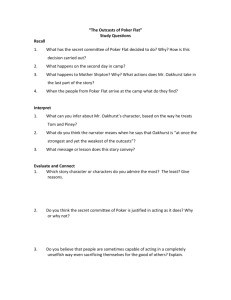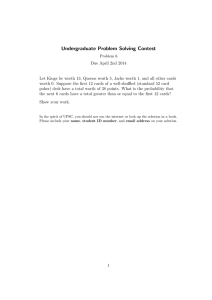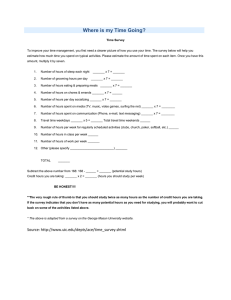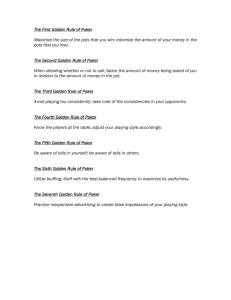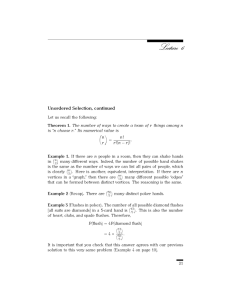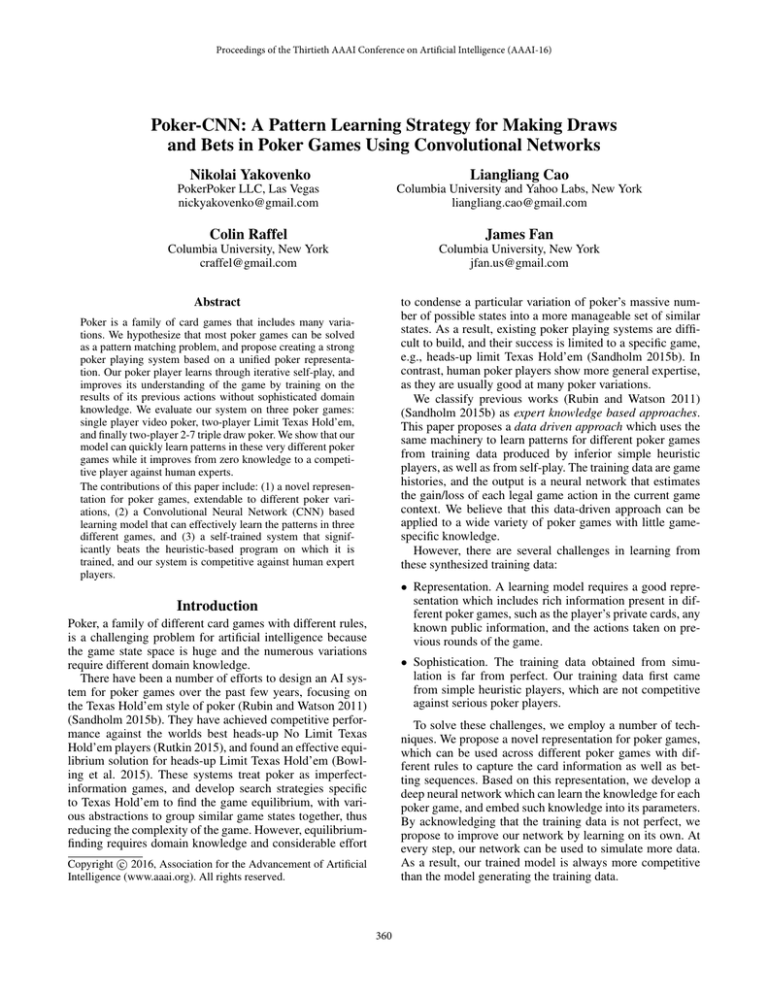
Proceedings of the Thirtieth AAAI Conference on Artificial Intelligence (AAAI-16)
Poker-CNN: A Pattern Learning Strategy for Making Draws
and Bets in Poker Games Using Convolutional Networks
Nikolai Yakovenko
Liangliang Cao
PokerPoker LLC, Las Vegas
nickyakovenko@gmail.com
Columbia University and Yahoo Labs, New York
liangliang.cao@gmail.com
Colin Raffel
James Fan
Columbia University, New York
craffel@gmail.com
Columbia University, New York
jfan.us@gmail.com
to condense a particular variation of poker’s massive number of possible states into a more manageable set of similar
states. As a result, existing poker playing systems are difficult to build, and their success is limited to a specific game,
e.g., heads-up limit Texas Hold’em (Sandholm 2015b). In
contrast, human poker players show more general expertise,
as they are usually good at many poker variations.
We classify previous works (Rubin and Watson 2011)
(Sandholm 2015b) as expert knowledge based approaches.
This paper proposes a data driven approach which uses the
same machinery to learn patterns for different poker games
from training data produced by inferior simple heuristic
players, as well as from self-play. The training data are game
histories, and the output is a neural network that estimates
the gain/loss of each legal game action in the current game
context. We believe that this data-driven approach can be
applied to a wide variety of poker games with little gamespecific knowledge.
However, there are several challenges in learning from
these synthesized training data:
Abstract
Poker is a family of card games that includes many variations. We hypothesize that most poker games can be solved
as a pattern matching problem, and propose creating a strong
poker playing system based on a unified poker representation. Our poker player learns through iterative self-play, and
improves its understanding of the game by training on the
results of its previous actions without sophisticated domain
knowledge. We evaluate our system on three poker games:
single player video poker, two-player Limit Texas Hold’em,
and finally two-player 2-7 triple draw poker. We show that our
model can quickly learn patterns in these very different poker
games while it improves from zero knowledge to a competitive player against human experts.
The contributions of this paper include: (1) a novel representation for poker games, extendable to different poker variations, (2) a Convolutional Neural Network (CNN) based
learning model that can effectively learn the patterns in three
different games, and (3) a self-trained system that significantly beats the heuristic-based program on which it is
trained, and our system is competitive against human expert
players.
• Representation. A learning model requires a good representation which includes rich information present in different poker games, such as the player’s private cards, any
known public information, and the actions taken on previous rounds of the game.
Introduction
Poker, a family of different card games with different rules,
is a challenging problem for artificial intelligence because
the game state space is huge and the numerous variations
require different domain knowledge.
There have been a number of efforts to design an AI system for poker games over the past few years, focusing on
the Texas Hold’em style of poker (Rubin and Watson 2011)
(Sandholm 2015b). They have achieved competitive performance against the worlds best heads-up No Limit Texas
Hold’em players (Rutkin 2015), and found an effective equilibrium solution for heads-up Limit Texas Hold’em (Bowling et al. 2015). These systems treat poker as imperfectinformation games, and develop search strategies specific
to Texas Hold’em to find the game equilibrium, with various abstractions to group similar game states together, thus
reducing the complexity of the game. However, equilibriumfinding requires domain knowledge and considerable effort
• Sophistication. The training data obtained from simulation is far from perfect. Our training data first came
from simple heuristic players, which are not competitive
against serious poker players.
To solve these challenges, we employ a number of techniques. We propose a novel representation for poker games,
which can be used across different poker games with different rules to capture the card information as well as betting sequences. Based on this representation, we develop a
deep neural network which can learn the knowledge for each
poker game, and embed such knowledge into its parameters.
By acknowledging that the training data is not perfect, we
propose to improve our network by learning on its own. At
every step, our network can be used to simulate more data.
As a result, our trained model is always more competitive
than the model generating the training data.
c 2016, Association for the Advancement of Artificial
Copyright Intelligence (www.aaai.org). All rights reserved.
360
We have evaluated our system on three poker variations.
Our Poker-CNN obtains an average return of $0.977±0.005
in video poker, which is similar to human players’ performance. For Texas Hold’em, Poker-CNN beats an open
source poker agent by a large margin, and it statistically ties
with a professional human player over a 500 hand sample.
Poker-CNN for the 2-7 triple draw poker game plays significantly better than the heuristic model that it trained on, performs competitively against a human expert, and was even
ahead of that human expert over the first 100 hands. 1
find that CNN works well for poker, and that it outperforms
traditional neural network models such as fully-connected
networks. Note that our approach is different from the works
in (Dahl 2001) (Tesauro 1994) since our network does not
assume expert knowledge of the poker game.
Representation
In order to create a system that can play many variations
of poker, we need to create a representation framework that
can encode the state-space in any poker game. In this paper,
we show how a 3D tensor based representation can represent three poker games: video poker, heads-up limit Texas
Hold’em and heads-up limit 2-7 triple draw.
Related Work
There have been many works in the domain of poker playing systems. For example, Bowling (Bowling et al. 2015)
have focused a great deal of research on heads-up limit Texas
Hold’em, and recently claimed that this limited game is now
essentially weakly solved.
Their works employ a method called Counterfactual Regret minimization (CFR) to find an equilibrium solution for
heads-up Limit Texas Holdem, which explores all possible
states in the poker game. Most existing work on CFR is applied to Texas Hold’em.
While CFR-based approaches have achieved breakthroughs in Texas Hold’em, there are limitations to adapting
them to other poker games. First, it is not easy or straightforward to generalize these works to other poker variations.
Second, because quite a few poker games have a search
space larger than heads-up limit Texas Hold’em, it is very
difficult to traverse the game states and find the best responses (Zinkevich et al. 2007) (Johanson et al. 2011) (Johanson et al. 2013a) for those games. For example, 2-7 triple
draw has 7 rounds of action instead of 4, and 5 hidden cards
instead of 2 as in limit Texas Hold’em. The number of states
is orders of magnitudes larger. It may not always be practical to create an abstraction to use the CFR algorithm, and to
find a Nash equilibrium solution with a reasonable amount
of computational resources (at least without ignoring some
game-state information).
The Carnegie Melon team’s winning No Limit Hold’em
entry recently challenged some of the best human players in
the world, in a long two-player No Limit Hold’em match.
Human experts won the match, but not by a definitive margin of error, despite playing 80,000 hands over two weeks
(Sandholm 2015a).
Most previous works on poker are limited to Texas
Hold’em. This paper outlines a data-driven approach for
general poker games. We propose a new representation for
poker games, as well as an accompanying way of generating huge amounts of training samples by self-playing
and iterative training. Our model is motivated by the recent success of Convolutional Neural Networks (CNNs) for
large scale learning (Fukushima 1980) (LeCun et al. 1998),
(Krizhevsky, Sutskever, and Hinton 2012) (Taigman et al.
2014). Similar to the recent progress for the board game go
(Clark and Storkey 2014; Maddison et al. 2014), and in reinforcement learning on video games (Mnih et al. 2015), we
Three poker games
1. Video poker: video poker is a popular single player single
round game played in casinos all over the world. A player
deposits $1, and is dealt five random cards. He can keep
any or all of the five cards, and the rest are replaced by
new cards from the deck. The player’s earning is based on
his final hand and a pay out table (e.g. a pair of kings earns
$1). Video poker is a simple game with a single player
move that has 32 possible choices.
2. Texas Hold’em: Texas Hold’em is a multi-player game
with four betting rounds. Two cards (hole cards) are dealt
face down to each player and then five community cards
are placed face-up by the dealer in three rounds - first
three cards (“the flop”) then an additional single card
(“the turn” or “fourth street”) and finally another additional card (“the river” or “fifth street”). The best five card
poker hand from either the community or their hole cards
wins. Players have the option to check, bet, raise or fold
after each deal.
3. 2-7 triple draw poker: Triple draw is also a multi-round
multi-player game. Each player is dealt five cards face
down, and they can make three draws from the deck, with
betting rounds in between. In each drawing round, players choose to replace any or all cards with new cards from
the deck. All cards are face-down, but players can observe how many cards his opponent has exchanged. Triple
draw combines both the betting of Texas Holdem and the
drawing of video poker. Also note that the objective of the
triple draw poker is to make a low hand, not a “high hand”
as in video poker. The best hand in 2-7 triple draw is 2, 3,
4, 5, 7 in any order.
As we can see, these three games have very different rules
and objectives with 2-7 triple draw poker being the most
complex. In the following section, we describe a unified representation for these games.
A Unified Representation for Poker Games
A key step in our Poker CNN model is to encode the game
information into a form which can be processed by the convolution network.
There are 13 ranks of poker cards and four suits,2 so we
use a 4 × 13 sparse binary matrix to represent a card. Only
1
Source code available at https://github.com/moscow25/deep
draw
2
361
c = club, d = diamond, h = heart, s = spade
one element in the binary matrix is non-zero. In practice,
we follow the work in (Clark and Storkey 2014) by zeropadding each 4 × 13 matrix to 17 × 17 size. Zero padding
does not add more information, but it helps the computation
with convolutions and max pooling. For a five card hand, we
represent it as a 5 × 17 × 17 tensor. We also add a full hand
layer (17 × 17) that is the sum of 5 layers to capture the
whole-hand information.
There are a number of advantages to such an encoding
strategy: First, a large input creates a good capacity for
building convolution layers. Second, the full hand representation makes it easy to model not only the individual cards,
but also common poker patterns, such as a pair (two cards of
the same rank, which are in the same column) or a flush (five
cards of the same suit, which are in the same row) without
game-specific card sorting or suit isomorphisms (e.g. AsKd
is essentially the same as KhAc). Finally, as we show next,
we are able to extend the poker tensor to encode game-state
context information that is not measured in cards.
For multiple round games, we would like to keep track
of context information such as the number of draw rounds
left and the number of chips in the pot. We do so by adding
layers to the 6 × 17 × 17 tensor. To encode whether a draw
round is still available, we use a 4 × 13 matrix with identical
elements, e.g. all “1” means this draw round is still available.
We pad this matrix to 17 × 17. For 2-7 Triple Draw, there are
three draw rounds, therefore we add three 17 × 17 matrices
to encode how many rounds are left. To encode the number
of chips in the pot, we add another layer using numerical
coding. For example, if the number of chips is 50, we encode
it as the 2c card, the smallest card in the deck. If 200, we use
2c&2d&2h&2s to encode it. A pot of size 2800 or more will
set all 52 cards’ entries to be 1.
We also need to encode the information from the bets
made so far. Unlike for a game like chess, the order of the
actions (in this case bets) used to get to the current pot size
is important. First we use a matrix of either all “0” or all
“1” to encode whether the system is first to bet. Then we use
5 matrices to encode all the bets made in this round, in the
correct order. Each matrix is either all “0” or all “1”, corresponding to 5 bits to model a full bet round. We similarly
encode previous betting rounds in sets of 5 matrices.
The final representation for triple draw is a 31 × 17 × 17
tensor whose entries are either 0 or 1. Table 1 explains encoding matrices for triple draw. To represent Texas Hold’em,
we just need to adjust the number of private cards to encode
the observed public cards and remove the draw rounds layer
since there is no card drawing by the player.
To the best of our knowledge, this is the first work to use
a 3D tensor based representation for poker game states.
every possible draw. In a poker game where the player can
have five cards, there are 25 = 32 possible choices per hand,
so the machine needs to estimate the gain/loss for each of
the possible 32 choices and select the choice with biggest
gain. Since the 2-7 Triple Draw game involves betting as
well as draws, and Texas Hold’em involves only betting, we
use video poker as an example to illustrate our approach to
learning to make optimal draws in a poker game.
In many cases, it is easy to heuristically judge whether a
hand includes a good draw or not. For example, a hand with
five cards of the same suit in a row is a straight flush, and
will be awarded $50 in video poker. If a player sees four
cards or the same suit in a row and an uncorrelated card, he
will give up the last card and hope for a straight flush. To
estimate the possibile gain for an action, we employ Monte
Carlo simulation and average the return. If with 1% probability the player wins $50 and the other 99% wins nothing,
the estimated return for this choice is $50 × 0.01 = $0.5.
To train a player for video poker, we employ Monte Carlo
simulation to generate 250,000 video poker hands. From
simulation, we obtain the expected gain/loss of each possible draw for each of these 250,000 hands.
Based on the representation introduced in the previous
section (without the betting information), we consider several models for predicting the player action with highest estimated value:
Fully connected neural network. Fully connected neural
networks, or multi-layer perceptrons, are efficient nonlinear models which can be scaled to a huge amount of
training examples. We use a model with two hidden layers with 1032 hidden units in each layer, and a final output
layer with 32 units. We also add a dropout layer before the
output to reduce overfitting.
Convolutional network with big filters. We believe it is
useful to learn 2D patterns (suits and ranks) to represent poker. The successful approaches in image recognition (LeCun et al. 1998) suggest using convolutional filters to recognize objects in 2D images. Motivated by their
work, we introduce a CNN model, named Poker-CNN,
which consists of two convolutional layers, one maxpooling layer, two more convolutional layers, one more maxpooling layer, one dense layer, and a dropout layer. The
filter size of this model is 5 × 5. The structure of our net-
Table 1: Features used as inputs to triple draw CNN
Feature
xCards
Learning
xRound
xPotSize
xPosition
xContext
A poker agent should take two types of actions in the game:
drawing cards and placing bets. In the following sections,
we describe how to learn these two types of actions.
Learning to draw
We consider the task of learning to make draws as the following: given a hand of poker cards, estimate the return of
362
No. matrices
5
1
3
1
1
5
5
5
5
Description
Individual private cards
All cards together
Number of draw rounds left
Number of chips in the pot
Is the player first to bet?
Bets made this round
Bets made previous round
# Cards kept by player
# Cards kept by opponent
the hand). There are two things worth pointing out. First, a
player need not be honest. He may bet or raise with a bad
hand in the hope of confusing his opponents. Second, no
player is perfect. Even world-class players make imperfect
choices in betting, nor will a player always make the same
choice in a given situation.
Ideally, we would like to use the same network as in Figure 1 to make bets. Differently from making draws, we predict the expected values of five output states, corresponding
to five betting actions. However, the challenge is that it is
no longer easy to use Monto Carlo simulation to collect the
average return of every betting choice.
To generate training examples for making bets in various game states, we propose to track the results in terms of
chips won or lost by this specific betting action. If a player
folds, he can not win or lose more chips, so his chip value is
$0. Otherwise, we count how many chips the player won or
lost with this action, as compared to folding. This includes
chips won or lost by future actions taken during the simulated hand.
We use a full hand simulation to generate training examples for the bets model. At the beginning, we employ two
randomized heuristic players to play against each other. A
simple but effective heuristic player is to randomly choose
an action based on a fixed prior probability. Our heuristic
player chooses a simple strategy of a 45% bet/raise, 45%
check/call, 10% fold baseline. Depending on whether it is
facing a bet, two or three of these actions are not allowed,
and will not be considered. During play, the probability of
choosing a betting action is adjusted to the current hand’s
heuristic value.3 This adjustment makes sure that the simulated agent very rarely folds a very good hand, while folding
a bad hand more often than it would an average hand. Given
a game state, we aim to predict the gain/loss of each possible
betting action. To train such a model, we use the gain/loss
of full hands simulation, which is back-propagated after the
hand finishes.
We generated 500,000 hands for training. In practice, we
first learn the network for making draws, and use the parameter values as initialization for the network for making bets.
As we did for learning to make draws, we use Nesterov momentum (Sutskever et al. 2013) for learning to make bets,
except that we use a smaller learning rate of 0.02 for optimization. Note that in every training example, the player
makes only one decision, so we only update parameters corresponding to the given action. Since our heuristic player is
designed to make balanced decisions, our network will learn
to predict the values of each of the five betting actions.
Figure 1: The structure of our poker-CNN.
work is shown in Figure 1.
Convolutional network with small filters. Some recent
work (Simonyan and Zisserman 2014) shows that it can
be beneficial to use a deep structure with small filters.
Motivated by this work, we use 3 × 3 filters in the
convolutional layers.
All of our models were implemented using Lasagne (Dieleman et al. 2015). We did not use a nonlinear SVM because it
would be prohibitively slow with a large number of support
vectors. All these models use mean squared error as the loss
function. Nesterov momentum (Sutskever et al. 2013) was
used to optimize the network with a learning rate of 0.1 and
momentum of 0.90.
We can use the same strategy to learn how to make draws
in other games. For 2-7 Triple Draw, simulating the value
of 32 possible choices is a bit more complicated, since there
are multiple draws in the game. We use depth-first search to
simulate three rounds of draws, then average the return over
all of the simulations. We train the Triple Draw model to
predict the odds of winning against a distribution of random
starting hands (rather than the average results against a payout table), which also have the ability to make three draws.
Thus the ground truth for triple draw simulation is an allin
value of 0.0 - 1.0, rather than a dollar value.
The CNN models for 2-7 Triple Draw are similar to those
for video poker, except that the input may contain more
matrices to encode additional game information, and there
are more filters in the convolutional layer. For example, the
number of filters for video poker is 16 in the first two convolutional layers and 32 in the last two layers. In contrast, the
number of filters for triple draw is 24 and 48, respectively.
For complex poker games like Texas Hold’em and 2-7
Triple Draw, we also need a model that can learn how to
make bets. Next, we consider the task of choosing when to
check, bet, raise, call or fold a hand. The task of making bets
is much harder than making draws, since it is not so simple
to produce ground truth through Monte Carlo simulation. In
the following sections we will discuss how our model learns
to make bets, and how it reacts to an opponent’s strategy.
Learning from inferior players
One concern about our learning model is that the training
examples are generated based on simple heuristic players,
hence these examples are not exhaustive, are prone to systemic biases, and are not likely to be representative of all
game situations.
We hypothesize that our model will outperform the simple
heuristic players from which it learns for two reasons. First,
Learning to bet
The fun part in most modern poker games is making bets.
In each round of betting, players act in turn, until all players have had a chance to bet, raise, or call a bet. The player
has at most five choices: “bet” (start to put in chips), “raise”
(increase the bet), “call” (match the previous bet made),
“check” (decline to make the first bet), and “fold” (give up
3
363
As estimated by the allin value.
our model is not learning to imitate the actions taken in the
heuristic-based matches, but rather it is using these matches
to learn the value of the actions taken. In other words, it
learns to imitate the actions that lead to positive results.
Second, the heuristic-based player’s stochastic decisionmaking includes cases where a player bets aggressively with
a weak hand (e.g. bluffing). Therefore, the resulting model
is able to learn the cases where bluffing is profitable, as well
as when to bet with a strong hand.
To further improve the performance of our models, we
vary our training examples by letting the new model not only
play against itself, but also against the past two iterations of
trained models. We find this strategy is very effective. For
our final model, we repeated the self-play refining process
8 times, each time with self-play against the current best
model, and also previous models. That way, the next version
of the model must play well against all previous versions,
instead of just exploiting the weaknesses of the latest model.
We will show the resulting improvement of iterative refining
in our experiments.
Table 3: Comparing errors for video poker models
model
heuristic
DNN
CNN 5 × 5
CNN 3 × 3
negl.
$0.005
1610
2327
2322
2467
tiny
<$0.08
53
348
413
353
small
<$0.25
1081
242
151
131
big
<$1.0
256
83
114
49
huge
$1.0+
0
23
8
8
Figure 2: Filters learned from video poker.
Experiments on Video Poker
Video poker is a simple game which only requires one to
make draws. We will discuss how our model plays on video
poker in this section so that it will be easier to understand
more complicated games in the next sections. Table 2 compares the performance of different models for video poker.
Note that if a player plays each hand perfectly, the average payout is $1.000, but few human players actually
achieve this result.4 Top human performance is usually 1%2% worse than perfect. 5 However, since video poker is a
simple game, it is possible to develop a heuristic (rule-based)
player that returns $0.90+ on the dollar.6
We compare our models with a perfect player and a
heuristic player. It is easy to see that all of our learning models outperform the random action player and the heuristic
player. The performance of our best model ($0.977) is comparable with a strong human player ($0.98-$0.99).
models by comparing the errors in each category. It is interesting to see that CNNs make fewer “big” mistakes than
DNNs. We believe this is because CNNs view the game
knowledge as patterns, i.e., combinations of suits and ranks.
Since the search space is very large, the CNN model has a
better chance to learn the game knowledge by capturing the
patterns in 2D space than a DNN might in 1D space, given a
fixed number of examples.
To demonstrate this, Figure 2 shows a sample of the filters
learned in the first layer of CNN network. These filters are
applied to a 5 × 17 × 17 tensor, representing the five cards
in 2D space. Vertical bars in the image are suggestive of a
filter looking for a pattern of cards of the same rank (pairs),
while horizontal bars in the image are suggestive of a filter
looking for cards of the same suit (flushes).
The experiments on video poker suggest that the CNN is
able to learn the patterns of what constitutes a good poker
hand, and estimate the value of each possible move, thus
deducing the move with the highest expected payout.
Table 2: Poker-CNN’s average return in the video poker.
model
perfect player
professional player
heuristic player
random action player
Fully connected network
CNN with 5 × 5 filters
CNN with 3 × 3 filters
average return
$1.000
$0.98 to $0.99
$0.916 ± 0.002
$0.339 ± 0.003
$0.960 ± 0.002
$0.967 ± 0.002
$0.977 ± 0.002
Experiments on Texas Hold’em & Triple Draw
We have discussed the simple video poker game in previous sections. Now we will discuss more complicated games:
heads-up limit Texas Hold’em and heads-up limit 2-7 Triple
Draw.
We first generate 500,000 samples from which our model
learns how to make draws (no draws for Texas Hold’em).
Then we let two heuristic players7 play against each other
for 100,000 hands and learn how to make bets based on those
hand results.
Since making bets is difficult, we let the model play
against itself, train on those results, and repeat this self-play
cycle a number of times. As mentioned before, each round
Table 3 takes a closer look at the differences in learning
4
That is why the casino always wins
http://www.videopokerballer.com/articles/10-video-pokermistakes/
6
Our heuristic uses four rules. A 25-rule player can return
$0.995 on the dollar. http://wizardofodds.com/games/video-poker/
strategy/jacks-or-better/9-6/intermediate/
5
7
Our heuristic player is based on each hand’s allin value against
a random opponent.
364
Table 4: Players’ earnings when playing against Poker-CNN
in heads up limit Texas Hold’em, with $50-$100 blinds. The
± amount indicates error bars for statistical significance.
Player
ACPC sample player
Heuristic player
CFR-1
Professional human player
Player earnings
-$90.9 ±7.0
-$29.3 ±5.6
-$93.2 ±7.0
+$21.1±30.5
Table 5: Different models play each other in 2-7 Triple Draw.
Results over 60,000+ hands, significant within ±$3.0 per
hand.
model
heuristic CNN-1 Pok-CNN
DNN
Heuristic
0
-$99.5
-$61.7 -$29.4
CNN-1
+$99.5
0
-$73.3 -$54.9
Pok-CNN
+$61.7 +$73.3
0 +$66.2
DNN
+$29.4 +$54.9
-$66.2
0
# hands
10000
10785
10000
527
Table 6: Poker-CNN vs human experts for 2-7 Triple draw.
of self-play consists of the latest CNN model playing against
the previous three models to avoid over-optimizing for the
current best model’s weaknesses.
For each training iteration, we generate 100,000 poker
hands, and from those, train on 700,000 betting events.
Our final Texas Hold’em model was trained for 8 self-play
epochs, while the Triple Draw model was trained for 20 selfplay epochs.
# hands
100
200
500
To evaluate the performance of poker player, we compare
our best Poker-CNN with the following models:
• “Random player” from ACPC.8
• The heuristic player, from which our model is trained.
• An open source implementation of a CFR player.9
Table 4 summarizes the results. The first notable result is
that our model outperforms the heuristic player from which
it learns. This supports our hypothesis that the poker playing
model can outperform its training data.
Our model also outperforms the random player and the
open source CFR player. The open source CFR (Gibson
2014) computes a Nash equilibrium solution using the “Pure
CFR” algorithm. This is the only public implementation we
can find for a version of the CFR algorithm used by the
ACPC Limit Hold’em champions. However, the limitation
of this implementation is that it abstracts all poker hands as
one bucket. Although it clearly illustrates the idea of CFR,
we recognize that its performance is not close to the best
CFR implementation to date. To remedy this, we asked a former professional poker player to compete against our model.
He won +21.1±30.5 over about 500 hands. From this result,
we can see that our model is competitive against a human expert, despite being trained without any Texas Hold’em specific domain knowledge.
Playing 2-7 triple draw poker
Triple draw is more complicated than Texas Hold’em, and
there is no existing solution for 2-7 triple draw. To validate
our performance, we compare the heuristic player, CNN-1
(trained by watching two heuristic players playing), the final
CNN player (after 20 iterations of self-play and retraining),
and a DNN, trained on the results of the Poker-CNN model.
The results show that CNN-1 beats the heuristic model by
9
champion vs CNN
+$64.0 ±67.5
+$76.2 ±47.7
+$97.6 ±30.2
large margin, despite being trained directly on its hands. Iterative training leads to improvement, as our model significantly outperforms both the heuristic model and CNN-1.
Our model outperforms the two-layer DNN with a gain of
$66.2, despite the DNN being trained on the CNN hands,
from the latest model.
Since there is no publicly available third-party 2-7 triple
draw AI to compete against, Poker-CNN model was pitted against human players. We recruited a former professional poker player (named as “expert”) and a world champion poker player (named as “champion”) to play against
our poker-CNN model.
Evaluating against an expert human player takes considerably longer than comparing two models, so our experts
only played 500 hands against the model. As Table 6 shows,
our model was leading the expert after 100 hands, and broke
even at the halfway point. The human expert player noted
that the CNN made a few regular mistakes and he was able
to recognize these after a while, thus boosting his win rate.
He also said that the machine was getting very lucky hands
early. It would be interesting to see if these weaknesses disappear with more training. By the end of the match, the human was playing significantly better than the model. The
play against the world champion shows similar patterns,
where the world champion improves his ability to exploit
the CNN. The world champion’s final performance against
the Poker-CNN is $97.6 ± 30.2, but praised our system after
the game on being able to play such a complicated game.
We think the results demonstrate that a top human player is
still better than our model, but we believe that the machine
is catching up quickly.
Playing Texas Hold’em
8
expert vs CNN
-$14.7 ±58.5
+$4.5 ±39.8
+$44.6 ±24.2
Discussion
The overarching goal of this work is to build a strong poker
playing system, which is capable of learning many different
poker games, and can train itself to be competitive with professional human players without the benefit of high-quality
training data.
However, we also wanted to show a process that is as
http://www.computerpokercompetition.org/
https://github.com/rggibson/open-pure-cfr
365
dent players in ten different poker games.12
At the very least, we would like to fully implement an
up-to-date version of the CFR algorithm for heads up Limit
Hold’em, which has has been shown to play within $6.5 per
hand of a perfectly unexploitable player on our $50-$100
blinds scale even when limited to 10,000 abstraction buckets
(which a single machine can reasonably handle (Johanson
et al. 2013b)). It would be interesting to see where PokerCNN places on the CFR exploitability spectrum, as well as
how much Poker-CNN could improve by training on hands
against a strong CFR opponent.
straightforward and domain-independent as possible. Hence,
we did not apply game-specific transformations to the inputs, such as sorting the cards into canonical forms, or augmenting the training data with examples that are mathematically equivalent within the specific game type.10 We should
try the former, training and evaluating hands in a canonical
representation. It is notable that human experts tend to think
of poker decisions in their canonical form, and this is how
hands are typically described in strategy literature.11 (Waugh
2013) and others have developed efficient libraries for mapping Texas Hold’em hands to their canonical form. It should
be possible to extend these libraries to other poker variants
on a per-game basis.
Within our existing training process, there are also other
optimizations that we should try, including sampling from
generated training data, deeper networks, more sophisticated
strategies of adaptively adjusting learning rates, and etc. We
feel these may not make a significant difference to the system’s performance, but are worth exploring.
Inspired by the success of (Mnih et al. 2015), we set
out to teach a deep Q-learning network to play poker from
batched self-play. However, it turned out that we could create a strong CNN player by training directly on hand results,
instead of training on intermediate values. This is possible
because the move sequences in poker are short, unlike those
for go, backgammon or chess, and that many moves lead
immediately to a terminal state. It will be interesting to see
how much better the system performs if asked to predict the
value of its next game state rather than the final result.
Lastly, in building our systems, we’ve completely avoided
searching for the best move in a specific game state, or explicitly solving for a Nash equilibrium game strategy. The
upside of our approach is that we generate a game strategy
directly from self-play, without needing to model the game.
As a bonus, this means that our method can be used to learn
a strategy that exploits a specific player, or a commonly occurring game situation, even if it means getting away from
an equilibrium solution. We should explore this further.
We acknowledge that broad-ranging solutions for complicated poker games will likely combine the data driven approach with search and expert knowledge modeling. It is our
understanding that the No Limit Texas Hold’em system that
competed to a statistical draw with the world’s best human
players (Rutkin 2015) already uses such a hybrid approach.
Recent works (Heinrich, Lanctot, and Silver 2015) have also
shown that it is possible to closely approximate a Nash equilibrium for heads-up Limit Texas Hold’em, using a Monte
Carlo search tree combined with reinforcement learning.
It would be interesting to see how these different approaches to the same underlying problem could be combined to create strong player models for very complicated
poker games, such as competing against six strong indepen-
Conclusion and future work
We have presented Poker-CNN, a deep convolutional neural
network based poker playing system. It learns from a general input representation for poker games, and it produces
competitive drawing and betting models for three different
poker variants. We believe that it is possible to extend our
approach to learn more poker games, as well as to improve
the ability of this model to compete on an even footing with
the best available equilibrium-learning models and professional poker players.
Perhaps not far from today, it will be possible to train a
poker model that can play any poker game spread at the
casino, at a level competitive with the players who make
a living playing these games. We would like to see PokerCNN make a contribution toward this future.
Acknowledgments
We would like to thank professional poker players Ralph
”Rep” Porter, Randy Ohel and Neehar Banerji for playing against Poker-CNN, as well as for invaluable insights
into the system’s performance. Thanks also to Eric Jackson
and Richard Gibson, for sharing their experience with CFR
methods for Limit and No Limit Texas Hold’em, as well as
for sharing some of their code with us.
References
Bowling, M.; Burch, N.; Johanson, M.; and Tammelin, O.
2015. Heads-up limit holdem poker is solved. Science
347(6218):145–149.
Clark, C., and Storkey, A. 2014. Teaching deep convolutional neural networks to play go. arXiv preprint
arXiv:1412.3409.
Dahl, F. A. 2001. A reinforcement learning algorithm applied to simplified two-player texas holdem poker. In Machine Learning: ECML 2001. Springer. 85–96.
Dieleman, S.; Schluter, J.; Raffel, C.; Olson, E.; Snderby,
S. K.; Nouri, D.; Maturana, D.; Thoma, M.; Battenberg,
E.; Kelly, J.; Fauw, J. D.; Heilman, M.; diogo149; McFee,
B.; Weideman, H.; takacsg84; peterderivaz; Jon; instagibbs;
Rasul, D. K.; CongLiu; Britefury; and Degrave, J. 2015.
Lasagne: First release.
10
In Texas Hold’em, there are 52 ∗ 51 = 2652 unsorted preflop private card combinations, but these form just 169 classes of
equivalent preflop hands.
11
A hand like KsAc is described as “Ace, King off-suit,” regardless of order or specific suit.
12
Known as “mixed” or “rotation” games by professional poker
players.
366
Fukushima, K. 1980. Neocognitron: A self-organizing
neural network model for a mechanism of pattern recognition unaffected by shift in position. Biological cybernetics
36(4):193–202.
Gibson, R. 2014. Regret Minimization in Games and the
Development of Champion Multiplayer Computer PokerPlaying Agents. Ph.D. Dissertation, University of Alberta.
Heinrich, J.; Lanctot, M.; and Silver, D. 2015. Fictitious
self-play in extensive-form games. In Proceedings of the
32nd International Conference on Machine Learning, ICML
2015, Lille, France, 6-11 July 2015, 805–813.
Johanson, M.; Waugh, K.; Bowling, M.; and Zinkevich, M.
2011. Accelerating best response calculation in large extensive games. In IJCAI, volume 11, 258–265.
Johanson, M.; Burch, N.; Valenzano, R.; and Bowling, M.
2013a. Evaluating state-space abstractions in extensive-form
games. In Proceedings of the 2013 international conference
on Autonomous agents and multi-agent systems, 271–278.
International Foundation for Autonomous Agents and Multiagent Systems.
Johanson, M.; Burch, N.; Valenzano, R.; and Bowling, M.
2013b. Evaluating state-space abstractions in extensiveform games. In Proceedings of the 2013 international
conference on Autonomous agents and multi-agent systems,
271–278. International Foundation for Autonomous Agents
and Multiagent Systems.
Krizhevsky, A.; Sutskever, I.; and Hinton, G. E. 2012.
Imagenet classification with deep convolutional neural networks. In NIPS, 1106–1114.
LeCun, Y.; Bottou, L.; Bengio, Y.; and Haffner, P. 1998.
Gradient based learning applied to document recognition.
PIEEE 86(11):2278–2324.
Maddison, C. J.; Huang, A.; Sutskever, I.; and Silver, D.
2014. Move evaluation in go using deep convolutional neural networks. arXiv preprint arXiv:1412.6564.
Mnih, V.; Kavukcuoglu, K.; Silver, D.; Rusu, A. A.; Veness, J.; Bellemare, M. G.; Graves, A.; Riedmiller, M.;
Fidjeland, A. K.; Ostrovski, G.; et al. 2015. Humanlevel control through deep reinforcement learning. Nature
518(7540):529–533.
Rubin, J., and Watson, I. 2011. Computer poker: A review.
Artificial Intelligence 175(5):958–987.
Rutkin, A. 2015. Ai wears its best poker face to take on the
pros. New Scientist 226(3020):21.
Sandholm, T. 2015a. Abstraction for solving large
incomplete-information games. In AAAI Conference on Artificial Intelligence (AAAI). Senior Member Track.
Sandholm, T. 2015b. Solving imperfect-information games.
Science 347(6218):122–123.
Simonyan, K., and Zisserman, A. 2014. Very deep convolutional networks for large-scale image recognition. CoRR
abs/1409.1556.
Sutskever, I.; Martens, J.; Dahl, G.; and Hinton, G. 2013.
On the importance of initialization and momentum in deep
learning. In ICML, 1139–1147.
Taigman, Y.; Yang, M.; Ranzato, M.; and Wolf, L. 2014.
Deepface: Closing the gap to human-level performance in
face verification. In CVPR.
Tesauro, G. 1994. Td-gammon, a self-teaching backgammon program, achieves master-level play. Neural computation 6(2):215–219.
Waugh, K. 2013. A fast and optimal hand isomorphism
algorithm. In AAAI Workshop on Computer Poker and Incomplete Information.
Zinkevich, M.; Johanson, M.; Bowling, M.; and Piccione,
C. 2007. Regret minimization in games with incomplete
information. In Advances in neural information processing
systems, 1729–1736.
367

